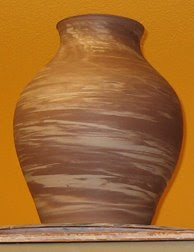Last week I was thinking big. Although I usually try to stick to basic functional forms (vases, bowls and mugs) last week I hunted the white elephant of ceramics - large vessels. They are, figuratively and literally, burdensome: difficult to throw, not terribly functional and heavy. But every potter knows they're the hardest form to do, so we throw ourselves into the task, griping as we go along.
 My greatest challenge in making the following forms was fighting with the new clay that the ACC sells. In high school, I was spoiled by having a clay mixer that my tenacious instructor acquired. Not only was the clay cheaper, but it was also more plastic, a must for throwing big pots. Of course, plasticity is always important in throwing, but you'll find yourself much more sensitive when you're trying to move up 10 pounds of clay.
My greatest challenge in making the following forms was fighting with the new clay that the ACC sells. In high school, I was spoiled by having a clay mixer that my tenacious instructor acquired. Not only was the clay cheaper, but it was also more plastic, a must for throwing big pots. Of course, plasticity is always important in throwing, but you'll find yourself much more sensitive when you're trying to move up 10 pounds of clay.Another pottery type I tackled last week was agateware. Inspired by the agate stone, this is a technique in which you use two or more colors of clay to allow the natural rhythm of the spinning wheel twist its own pattern in the clay. It's easier to show you what I mean.

Many potters create their two colors of clay by using a base white and adding colored slip to it, but I usually take the simple route and use the colors of clay available in the ACC -- red, white and brown. There's a lot of variety available even with just two colors, depending on how much you wedge the clay. If you take two equal pieces of clay, slap them together and throw, you'll have much larger, bolder and more contrasted patterns. If you wedge the two colors for a while, being careful not to actually blend them, you'll have a much more stratified effect, like in the one I threw. I love agateware because you can study the patterns and see how the clay moved as you threw the pot. It's almost like a record of the pot's birth.


No comments:
Post a Comment